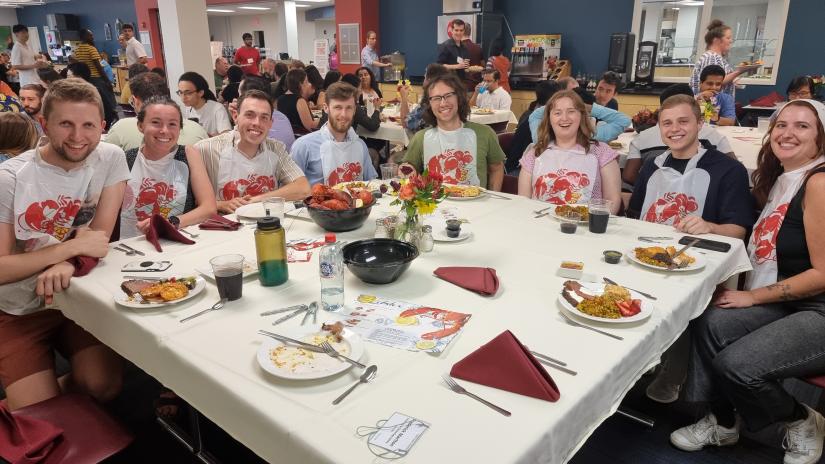Chancellor’s Research Fellow Dr Fred Marlton works in the UTS School of Mathematical and Physical Sciences. A materials scientist who is primarily interested in understanding structure-property relationships in functional materials, his research focuses on determining the atomic-scale features in perovskite materials that improve their performance in solid-state cooling and solar cells.
A Fulbright Scholarship experience

Fred's work aims to make these materials more efficient, less toxic and more stable, which could lead to cheaper and more environmentally friendly solar cells.
In 2024, Fred participated in the Fulbright program, a flagship foreign exchange scholarship program of the US, aimed at increasing binational research collaboration, cultural understanding and the exchange of ideas.
“The Fulbright program is an excellent opportunity because it allows you to set your own project, objective, university and host in your proposal so that you can do the research you want to do,” Fred said.
Material properties at the atomic scale
Fred works primarily on the crystal or atomic structure, and regularly conducts neutron and X-ray experiments at large-scale facilities, such as the Australian Synchrotron, the Australian Centre for Neutron Scattering, Oak Ridge National Lab, Diamond Light Source or European Synchrotron and Radiation Facility.
“Everything is made up of building blocks, whether we’re looking at a building or house or block of concrete. Then we go down to what we call the atomic scale where the arrangement of atoms affects the physical properties,” Fred explained,
“What I specialise in is looking at things at the atomic scale to understand how the arrangement of atoms, like building blocks, affects their properties.”
This work is particularly relevant to selecting materials for use in solar cells.
The Fulbright program supported Fred to travel to Stanford University, where he worked with a group investigating new materials used in the photovoltaic and semiconductor space called halide perovskites.
Making low-carbon solar cells
Fred said the Stanford team had great capabilities to make new materials, including halide perovskites, that can be used in solar cells or other semiconductor applications.
“I was able to contribute to this research by providing a fundamental understanding of how these things work,” he said.
If we work out ways to lower their toxicity and improve their stability, we can make solar cells that are cheap, efficient and have a low carbon footprint.
Currently, the process of making silicon based solar cells requires a lot of energy. By contrast, halide perovskites can be made in a very low energy process where less carbon is produced. While there are some concerns with toxicity and stability, Fred hopes his research will be able to improve the process for making halide perovskites.
“If we work out ways to lower their toxicity and improve their stability, we can make solar cells that are cheap, efficient and have a low carbon footprint,” he said.
The pros and cons of international collaboration
Fred praised the Fulbright program for its breadth of opportunity. While Fred’s wife encouraged him to apply for the program, the biggest challenge he faced was being away from his family.
“The silver lining was that my wife and daughter got to spend time with me in California for about a month and so we got to somewhat enjoy the Fulbright program together.”
Other challenges he faced included considering the costs and benefits of pursuing the Fulbright opportunity.
“You’ve got to work hard, be smart and overcome problems. I feel like that is always the case, but the biggest thing for me was the cost benefit analysis,” he said. “Fortunately, I was able to find a research project and host that provided me with a lot of opportunity.”
Before I was accepted into the program, I made the effort to plan well in advance so that when I got to Stanford, I could hit the ground running. As a result, I had research to do from the beginning.
Fred was able to make the business case that this experience would be beneficial not just towards his own career, but for the Faculty of Science and UTS as a whole.
He noted the importance of planning ahead as he prepared his application.
“I already had a lot of collaborations to begin with. Before I was accepted into the program, I made the effort to plan well in advance so that when I got to Stanford, I could hit the ground running. As a result, I had research to do from the beginning,” he said, adding that having a well organised, structured program and planning ahead makes a big difference.
Fred said international research experiences like those offered by the Fulbright program are valuable because you meet people with different ways of thinking, from different walks of life and with different ways of doing research.


“It was fantastic to be in an environment where I could provide new insights and new ideas, even though I have always had feelings of imposter syndrome,” he said.
“You never know where you might have value. But at the same time, you never know when someone else would be able to provide value to you.”
Fred enjoyed being in the position where people appreciated his supervision.
“Some of the PhD students really appreciated the input I gave them,” he said.
Whether you work in Arts or Science or Engineering, Fred said that if you’ve got a good idea, there’s a good chance they will take you on.
“You need to be in it to win it! There’s always a good chance of failure, but if you succeed and there’s opportunity, you’ve got to step out of your comfort zone,” he said.
You need to be in it to win it! There’s always a good chance of failure, but if you succeed and there’s opportunity, you’ve got to step out of your comfort zone.
Fred’s research career pathway
Fred obtained his Bachelor of Engineering and Bachelor of Science from the Australian National University in 2013. He completed his PhD at the University of New South Wales with Associate Professor John Daniels, focusing on using combinatorial methods and high energy X-ray diffraction to explore lead-free ferroelectrics.
He has worked as a postdoctoral researcher at Aarhus University in Denmark and the University of Sydney, where he became highly experienced in using total scattering to understand disorder and local structures in functional materials.

In 2023, Fred was awarded a UTS Chancellor’s Research Fellowship.
As a result of his Fulbright experience, Fred will continue working on international collaborations with people at Stanford and beyond.
“I’m also looking to try and establish my own research group here at UTS and to establish myself as a leader within my field in terms of Sydney and the broader Australian academic community,” he said, adding that his long term goal is to be in a position where people seek him out to contribute to their research.